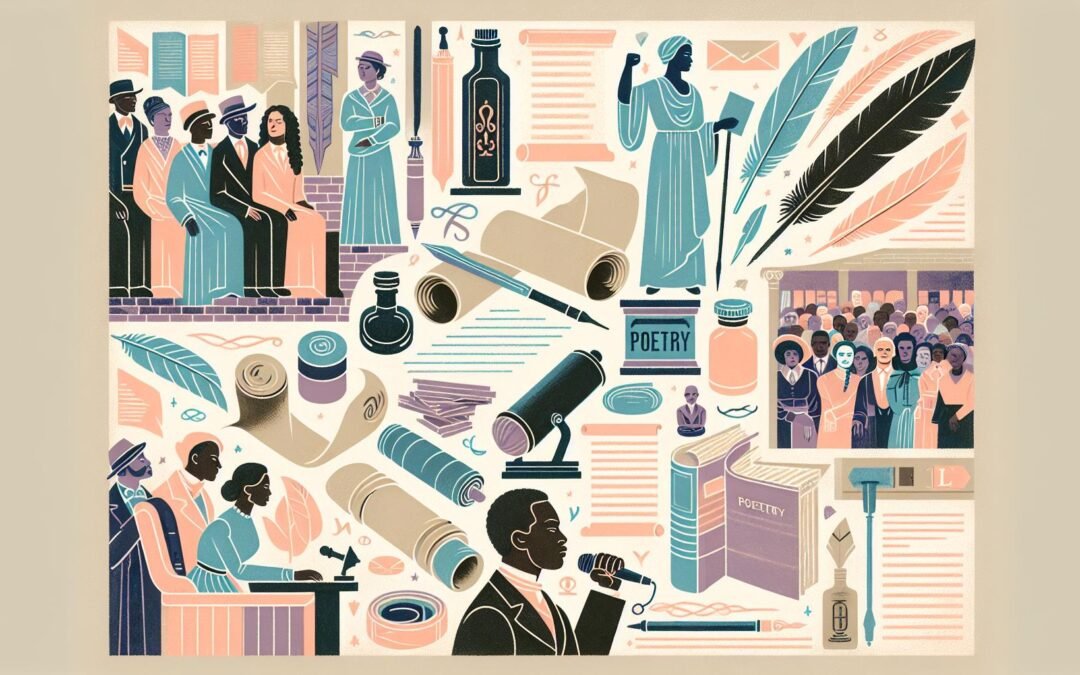Civil rights poetry exerts unparalleled influence by rendering the ongoing African American struggle as vivid, tactile experience. Its emergence, rooted in cycles of brutality and perseverance, stems directly from the social, political, and psychological conditions that shaped Black communities from the early twentieth century through the postwar decades. The Great Migration and Harlem’s thriving cultural capital provided not only escape from southern repression but also new structures for literary expression and collective agency. Organizations such as the NAACP, the National Urban League, and grassroots activists responded to state-sanctioned violence and segregation by forging liberatory networks, catalyzing protest that reverberated from courtrooms into the pages of magazines like “The Crisis”. The Harlem Renaissance artists, although preceding the modern Civil Rights Movement, interrogated Black identity, refuting dominant narratives and framing poetry as urgent, public intervention. Interest in Black experience evolved across poetry, drama, essay, and music, setting in motion aesthetic templates for later generations. Works from this tradition share kinship with forms seen in Best Love Poetry Books, though their function rests in survival, documentation, and resistance, not romance.
Civil Rights Poetry: Historical Roots and Transformative Movements
The manifold terrain of civil rights poetry emerges from lived oppression and collective insurgency, not from detached observation. Under Jim Crow, Black populations in the South and those who migrated North navigated a dual reality: overt legal discrimination and evolving social barriers. Inflamed by horrors of lynching, disenfranchisement, redlining, and public humiliation, poets like James Weldon Johnson and Anne Spencer imbued their verse with accountability and protest. Early to mid-century poems circulated through presses such as The Chicago Defender and Best Contemporary Poets, bolstering local and national momentum for social change. The Harlem Renaissance channeled global modernism with distinct urgency, redefining what belonged to Black creative labor and memory.
Expansion of Activism and Literary Collaboration
The postwar period marked a dramatic intensification of community action. African American veterans, inspired by the rhetoric of democracy abroad, demanded justice at home. The 1954 Brown v. Board of Education ruling destabilized segregation’s legal basis, yet unleashed a wave of white supremacist backlash. Freedom Riders, teachers, clergy, and unionists converged to resist, their ranks swelling after the Montgomery bus boycott. Poets including Gwendolyn Brooks and Robert Hayden responded in real time, their words intersecting policy, riot, grievance, and hope. Poems recited at churches, schools, and marches became acts of affirmation and memorial, echoing orality and communal ritual. This fusion of activism and artistry extended into landmark anthologies; Black presses assembled works by Margaret Walker, Dudley Randall, and Audre Lorde, cementing poetry as tool for solidarity.
Critical Flashpoints and Artistic Revolution
With the 1960s, physical and artistic boundaries blurred during moments of acute state violence. Murders of Emmett Till, Medgar Evers, and the assassination of Martin Luther King, Jr. shattered illusions of American innocence. Poets delivered testimony that opposed the monolithic narratives amplified by mainstream media. Amiri Baraka, Sonia Sanchez, and Nikki Giovanni foretold collective futures by reconstructing blues-inflected, improvisational, unapologetic language in the spirit of the Black Arts Movement. Visual artists and dramatists, collaborating with poets, transformed performance venues into spaces of resistance and catharsis. Songs, rallies, and public readings became catalysts, invoking the audience as participant and witness. The media’s portrayal of both protest and poetry, particularly during Selma and Birmingham confrontations, revealed the pivotal role of representation in advancing or obstructing progress. Surveillance, intimidation, and censorship by state actors prompted innovative poetic strategies, as metaphor, allegory, and veiled critique shielded both writers and their communities from reprisal.
Distinguishing Civil Rights Poetry: Form, Voice, and Community
Distinct from other protest literatures, civil rights poetry defines itself through sustained, purposeful engagement with anti-Blackness and its effects on consciousness and structure in the United States. Its tradition draws on oral narrative, spirituals, sermon rhythms, and blues improvisation, making performance inseparable from text. Instrumental works such as “For My People” by Margaret Walker and “We Real Cool” by Gwendolyn Brooks entwine public history with intimate portraiture, showing how communal strife and personal revelation coalesce. Unlike broader protest genres, its lines prioritize reclamation of narrative and formal innovation, evident in free verse, ballad, elegy, and call-response techniques. Such poetry stands apart from the tradition of One Flesh by Elizabeth Jennings, employing shared structures of rhythm and emotion for public, rather than exclusively private, ends.
Key Poets and Hallmark Texts
Langston Hughes anchors the lineage, fusing blues, jazz, and unadorned vernacular in masterpieces like “Let America Be America Again.” His approach models accessibility and social critique: a template for future generations. Gwendolyn Brooks masterfully renders the interior and collective dimensions of Black life: “The Chicago Defender Sends a Man to Little Rock” exposes systemic violence while “We Real Cool” distills communal risk and youthful bravado. Robert Hayden’s “Middle Passage” excavates ancestral trauma, countering amnesia with formal rigor. Maya Angelou’s “Still I Rise” and “Phenomenal Woman” illuminate Black womanhood’s dignity. Amiri Baraka combusts convention, declaring poems must serve as action, not ornament. Lucille Clifton, June Jordan, and Audre Lorde foreground intersectionality, naming the entanglement of race, gender, sexuality, and survival. Their bodies of work collectively redefine the meaning of public verse, staking claim as testimony and prophecy.
Performance, Orality, and Communal Space
The soundscape of civil rights poetry emerges from spirituals, sermons, folk song, and community ritual. Public performance at meetings, marches, classrooms, and segregated churches breathes vitality, bridging speaker and audience. Techniques of call-and-response, code-switching, repetition, and musical modulation transform listeners into participants. Recitation at rallies invokes memory and solidarity, confirming poetry’s function as tool for both mourning and mobilization. This tradition reaches contemporary venues and digital platforms, paralleling transmission modes recognized in Good Night Poems For Crush when boundaries between intimate and public voice dissolve.
Themes and Legacy: Liberation, Identity, Endurance
Freedom forms the lodestar for civil rights poetry, always conceived in negotiation against shifting constraints, not as static bequest. Justice pulses through lyric meditations, rallying cries, elegiac verses, and invocations of ancient history. More than documenting conditions, these poems court futurity, envisioning alternate realities where citizenship and dignity become embodied. Racial pride and reclamation pervade the most celebrated texts: grandmother, preacher, worker, child become archetypes within this literature, shaping the mythology by which Black life is known and protected. Sexuality, religious doubt, migrancy, generational change, and remixed folklore circulate throughout the tradition, contesting and reimagining the possible. In this living archive, tropes of the phoenix, river, and oak symbolize endurance that emerges not from passivity but ongoing, conscious resistance.
Impact and Reception Across Time
The reach of civil rights poetry widened with university curricula, anthologies, public broadcasting, and international solidarity, paralleling anti-colonial movements and dialogues with writers in Africa, the Caribbean, and Europe. Black-owned publishers, small magazines, and performance festivals enabled works to survive official censorship and market exclusion. In contemporary discourse, these poems shape memory, activism, scholarship, and artistic experimentation, all while tracing their stylistic roots through changes in American poetics visible in traditions like Romantic Poems For Wife. Major archives, from the Library of Congress to the Schomburg Center, house both original manuscripts and recordings.
Continuities and Innovation
Civil rights poetry never adhered to a singular style or doctrine. From the formal elegance of Hayden and Brooks to the confrontational improvisation of Baraka and Sanchez, poetics reflected both individual vision and collective need. Contemporary poets extend this inheritance by confronting mass incarceration, police brutality, and intersectional injustice, employing digital media and worldwide networks of affiliation. Performance remains essential: spoken word stages and online forums channel the same communal, urgent energy seen since the earliest freedom songs. Readers of Dirty Roses Are Red Poems may discover how seemingly unrelated genres share a performative, socially embedded impulse, though with divergent aims.

